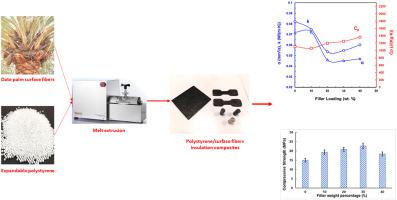Journal of Building Engineering ( IF 6.4 ) Pub Date : 2023-06-01 , DOI: 10.1016/j.jobe.2023.106982 Mohsin Raza , Hyder Al Abdallah , Mohamad Kozal , Alaa Al Khaldi , Tariq Ammar , Basim Abu-Jdayil

|
This study is the first to use date palm surface fibers, an underutilized waste, to develop thermoplastic insulation composites. The building sector accounts for approximately 40% of global energy consumption, making energy efficiency in buildings a critical concern. The composites were produced by melting expandable polystyrene (PS) and date palm surface fibers (DSF) at different weight percentages (10–40%) to increase biodegradability and promote renewability. The developed insulation composites exhibited excellent thermal properties with a low thermal conductivity of 0.053 and a low thermal diffusivity of 0.045 . Thermogravimetric analysis showed high thermal stability, with a greater than 300 °C and a mass loss of only approximately 6%. Differential scanning calorimetry indicated a higher glass transition of, approximately 100 °C. Application lifetime analysis showed that the PS–DSF composites maintained approximately 100% of their mass over 10 years when exposed to temperatures ranging from 30 to 120 °C, demonstrating their suitability for long-term insulation applications. The inclusion of DSF also exhibited positive synergistic effects on thermal stability. The insulation composites displayed improved compressive strength (19.33–22.66 MPa) compared to that of pure PS. Using thermoplastics and lignocellulosic waste in insulation composites is a practical, cost-effective, and environment-friendly solution for the construction industry.
中文翻译:

用于建筑可持续隔热的聚苯乙烯-枣椰树表面纤维复合材料的开发和表征
这项研究首次使用枣椰树表面纤维(一种未充分利用的废物)来开发热塑性绝缘复合材料。建筑行业约占全球能源消耗的 40%,这使得建筑物的能源效率成为一个关键问题。该复合材料是通过熔化不同重量百分比 (10–40%) 的可发性聚苯乙烯 (PS) 和海枣表面纤维 (DSF) 生产的,以提高生物降解性和促进可再生性。开发的绝缘复合材料表现出优异的热性能,导热系数低至 0.053和 0.045 的低热扩散率. 热重分析表明热稳定性高,具有大于 300 °C,质量损失仅约 6%。差示扫描量热法表明更高的玻璃化转变的,大约 100 °C。应用寿命分析表明,PS - DSF 复合材料在暴露于 30 至 120 °C 的温度范围内时,在 10 年内保持了大约 100% 的质量,证明了它们对长期绝缘应用的适用性。DSF 的加入也对热稳定性表现出积极的协同作用。与纯 PS 相比,绝缘复合材料显示出更高的抗压强度 (19.33–22.66 MPa)。在绝缘复合材料中使用热塑性塑料和木质纤维素废料是建筑行业实用、经济且环保的解决方案。


























 京公网安备 11010802027423号
京公网安备 11010802027423号